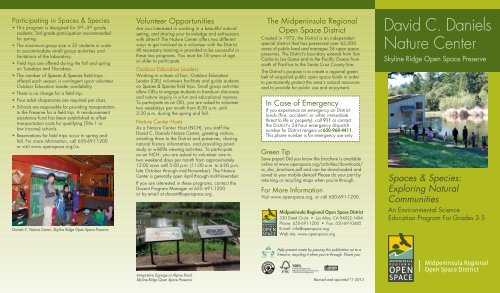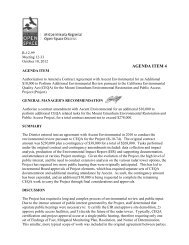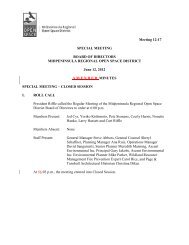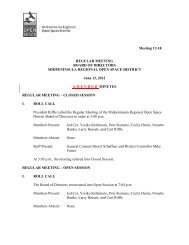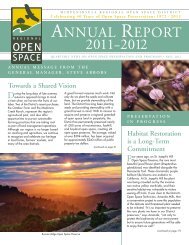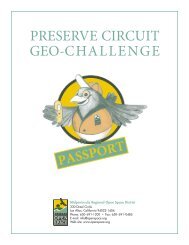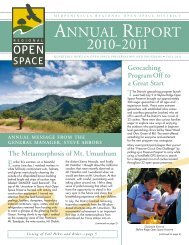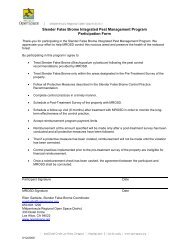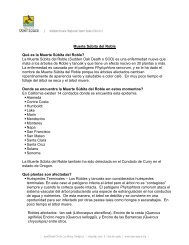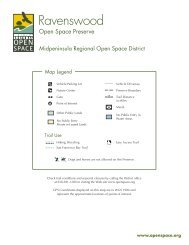Spaces and Species: Exploring Natural Communities
Spaces and Species: Exploring Natural Communities
Spaces and Species: Exploring Natural Communities
You also want an ePaper? Increase the reach of your titles
YUMPU automatically turns print PDFs into web optimized ePapers that Google loves.
Participating in <strong>Spaces</strong> & <strong>Species</strong><br />
• This program is designed for 3 rd –5 th grade<br />
students; 3rd grade participation recommended<br />
for spring.<br />
• The maximum group size is 32 students in order<br />
to accommodate small group activities <strong>and</strong><br />
limitations of the laboratory.<br />
• Field trips are offered during the fall <strong>and</strong> spring<br />
on Tuesdays <strong>and</strong> Thursdays.<br />
• The number of <strong>Spaces</strong> & <strong>Species</strong> field trips<br />
offered each season is contingent upon volunteer<br />
Outdoor Education Leader availability.<br />
• There is no charge for a field trip.<br />
• Four adult chaperones are required per class.<br />
• Schools are responsible for providing transportation<br />
to the Preserve for a field trip. A reimbursement<br />
assistance fund has been established to offset<br />
transportation costs for qualifying (Title 1 or<br />
low income) schools.<br />
• Reservations for field trips occur in spring <strong>and</strong><br />
fall. For more information, call 650-691-1200<br />
or visit www.openspace.org/ss.<br />
Volunteer Opportunities<br />
Are you interested in working in a beautiful natural<br />
setting, <strong>and</strong> sharing your knowledge <strong>and</strong> enthusiasm<br />
with others? The Nature Center offers two different<br />
ways to get involved as a volunteer with the District.<br />
All necessary training is provided to be successful in<br />
these two programs. You must be 18 years of age<br />
or older to participate.<br />
Outdoor Education Leaders<br />
Working in a team of four, Outdoor Education<br />
Leader (OEL) volunteers facilitate <strong>and</strong> guide students<br />
on <strong>Spaces</strong> & <strong>Species</strong> field trips. Small group activities<br />
allow OELs to engage students in h<strong>and</strong>s-on discovery<br />
<strong>and</strong> nature inquiry in a fun <strong>and</strong> educational manner.<br />
To participate as an OEL, you are asked to volunteer<br />
two weekdays per month from 8:30 a.m. until<br />
2:30 p.m. during the spring <strong>and</strong> fall.<br />
Nature Center Hosts<br />
As a Nature Center Host (NCH), you staff the<br />
David C. Daniels Nature Center, greeting visitors,<br />
orienting them to the District <strong>and</strong> preserves, sharing<br />
natural history information, <strong>and</strong> providing pond<br />
study or wildlife viewing activities. To participate<br />
as an NCH, you are asked to volunteer one to<br />
two weekend days per month from approximately<br />
12:00 noon until 5:00 p.m. (11:00 a.m. to 4:00 p.m.<br />
late October through mid-November). The Nature<br />
Center is generally open April through mid-November.<br />
If you are interested in these programs, contact the<br />
Docent Program Manager at 650-691-1200<br />
or by email at docent@openspace.org.<br />
The Midpeninsula Regional<br />
Open Space District<br />
Created in 1972, the District is an independent<br />
special district that has preserved over 62,000<br />
acres of public l<strong>and</strong> <strong>and</strong> manages 26 open space<br />
preserves. The District’s boundary extends from San<br />
Carlos to Los Gatos <strong>and</strong> to the Pacific Ocean from<br />
south of Pacifica to the Santa Cruz County line.<br />
The District’s purpose is to create a regional greenbelt<br />
of unspoiled public open space l<strong>and</strong>s in order<br />
to permanently protect the area’s natural resources<br />
<strong>and</strong> to provide for public use <strong>and</strong> enjoyment.<br />
In Case of Emergency<br />
If you experience an emergency on District<br />
l<strong>and</strong>s (fire, accident, or other immediate<br />
threat to life or property), call 911 or contact<br />
the District’s 24-hour emergency dispatch<br />
number for District rangers at 650-968-4411.<br />
This phone number is for emergency use only.<br />
Green Tip<br />
Save paper! Did you know this brochure is available<br />
online at www.openspace.org/activities/downloads/<br />
ss_dnc_brochure.pdf <strong>and</strong> can be downloaded <strong>and</strong><br />
saved to your mobile device? Please do your part by<br />
returning or recycling maps when you’re through.<br />
For More Information<br />
Visit www.openspace.org, or call 650-691-1200.<br />
David C. Daniels<br />
Nature Center<br />
Skyline Ridge Open Space Preserve<br />
<strong>Spaces</strong> & <strong>Species</strong>:<br />
<strong>Exploring</strong> <strong>Natural</strong><br />
<strong>Communities</strong><br />
Daniels C. Nature Center, Skyline Ridge Open Space Preserve<br />
Midpeninsula Regional Open Space District<br />
330 Distel Circle • Los Altos, CA 94022-1404<br />
Phone: 650-691-1200 • Fax: 650-691-0485<br />
E-mail: info@openspace.org<br />
Web site: www.openspace.org<br />
An Environmental Science<br />
Education Program For Grades 3-5<br />
Help prevent waste by passing this publication on to a<br />
friend or recycling it when you’re through. Thank you.<br />
Interpretive Signage at Alpine Pond,<br />
Skyline Ridge Open Space Preserve<br />
PRINTED WITH<br />
SOY INK<br />
Revised <strong>and</strong> reprinted 11-2013<br />
Midpeninsula Regional<br />
Open Space District
David C. Daniels Nature Center<br />
The David C. Daniels Nature Center facility is one<br />
of a kind – the only one the District has built <strong>and</strong><br />
operates to date. Conceptualized as early as 1985,<br />
built in 1995, <strong>and</strong> opened to the public in 1996,<br />
the Daniels Nature Center was funded in part by the<br />
Peninsula Open Space Trust in partnership with the<br />
David <strong>and</strong> Judy Daniels family in memory of their<br />
son David C. Daniels.<br />
The 600-square-foot building is mighty in attributes<br />
even if small in size. The focus of the Daniels Nature<br />
Center is to interpret the local environment (both<br />
flora <strong>and</strong> fauna) of Skyline Ridge Preserve, with<br />
an emphasis on Alpine Pond.<br />
Pond strata mobiles hang from the ceiling to<br />
imaginatively depict the plants <strong>and</strong> animals that<br />
live at different depths in a pond.<br />
There is a large-scale natural communities exhibit<br />
with a h<strong>and</strong>s-on element that allows visitors to<br />
create a pond food web, <strong>and</strong> discover that four<br />
natural communities (often thought of as habitats )–<br />
grassl<strong>and</strong>, mixed evergreen forest, chaparral, <strong>and</strong><br />
pond – surround the area just outside the Daniels<br />
Nature Center.<br />
Other features include a Skulls <strong>and</strong> Skins display,<br />
where children especially like to compare different<br />
animals <strong>and</strong> make observations. The Daniels<br />
Nature Center is also home to a live, captive-bred<br />
gopher snake.<br />
Multimedia Nature Tours<br />
The District offers self-guided, nature tours, similar<br />
to audio tours found in museums. District staff <strong>and</strong><br />
docents guide you down the trail with audio<br />
narrative <strong>and</strong> encourage you to see things you<br />
might otherwise miss on your hike. Listening devices<br />
with multiple languages (English; Spanish; Chinese)<br />
are available for check-out from the Daniels Nature<br />
Center. Two audio tours are available – a short<br />
family-focused version around Alpine Pond, <strong>and</strong><br />
a longer hike (approximately 2 miles) that takes<br />
you through four different natural communities or<br />
habitat types. The nature tours are also available<br />
for downloading or viewing from the District’s<br />
Web site. For more information, visit the Web<br />
site: www.openspace.org/naturetours.<br />
Daniels C. Nature Center, Skyline Ridge Open Space Preserve<br />
Hours of Operation:<br />
Weekends, generally from 12:00 noon to 5:00 p.m.,<br />
April through mid-October (11:00 a.m. to 4:00 p.m.<br />
late October through mid-November).<br />
The Daniels Nature Center is open to the public free of<br />
charge <strong>and</strong> staffed by volunteer Nature Center Hosts.<br />
Additional information about Skyline Ridge Preserve<br />
<strong>and</strong> Alpine Pond is also available to visitors when<br />
the Nature Center is closed. Interpretive signs on the<br />
exterior wall of the Nature Center <strong>and</strong> adjacent to<br />
the building provide information on the Preserve’s<br />
history, local wildlife, <strong>and</strong> an overview of the pond<br />
<strong>and</strong> its inhabitants.<br />
A 0.5-mile trail loops around Alpine Pond, providing<br />
visitors with an opportunity to enjoy a short, easyaccess<br />
hike.<br />
How to Get There:<br />
Skyline Ridge Open Space Preserve is just a<br />
35-minute drive from Palo Alto, <strong>and</strong> features<br />
scenic Alpine Pond <strong>and</strong> the Daniels Nature Center.<br />
For convenient access to the Daniels Nature Center<br />
<strong>and</strong> Alpine Pond, park in the Russian Ridge Open<br />
Space Preserve parking lot, located on the northwest<br />
corner of the Page Mill Road/Alpine Road <strong>and</strong><br />
Skyline Boulevard (Highway 35) intersection<br />
(across Skyline Boulevard on the right). Walk<br />
through the tunnel under Alpine Road to reach<br />
the Daniels Nature Center.<br />
<strong>Spaces</strong> & <strong>Species</strong>:<br />
<strong>Exploring</strong> <strong>Natural</strong> <strong>Communities</strong><br />
<strong>Spaces</strong> & <strong>Species</strong> is an innovative environmental<br />
science education field trip program offered at<br />
Skyline Ridge Preserve, <strong>and</strong> the Daniels Nature<br />
Center. In this unique setting, children have the<br />
opportunity to focus on the connections between<br />
themselves <strong>and</strong> their natural world, <strong>and</strong> begin to<br />
underst<strong>and</strong> the importance <strong>and</strong> benefit of open<br />
space in their community.<br />
<strong>Spaces</strong>: natural environments that provide homes for<br />
wildlife <strong>and</strong> places of special significance to people.<br />
<strong>Species</strong>: all the different forms of life— mammals,<br />
birds, fish, reptiles, amphibians, plants, insects,<br />
bacteria, <strong>and</strong> micro-organisms that inhabit<br />
the Earth.<br />
The Main Theme<br />
Appreciation of <strong>and</strong> caring for the environment is<br />
the underlying theme of <strong>Spaces</strong> & <strong>Species</strong>. Key<br />
concepts support this theme through h<strong>and</strong>s-on<br />
learning experiences. The concepts are:<br />
• All living organisms must have a habitat.<br />
• All living organisms are interdependent with each<br />
other <strong>and</strong> with the physical environment.<br />
• Living creatures have adaptations that help them<br />
survive in their habitat.<br />
• Each organism fills a specific niche in<br />
the environment.<br />
• Nature is constantly changing.<br />
• People can choose to act responsibly toward<br />
all living things <strong>and</strong> the environment.<br />
Program Design<br />
The <strong>Spaces</strong> & <strong>Species</strong> program offers:<br />
• Small groups;<br />
• An outdoor setting;<br />
• Individual attention from specially trained<br />
Outdoor Education Leaders (volunteers);<br />
• Program content aligned with California<br />
curriculum st<strong>and</strong>ards;<br />
• Sensory activities <strong>and</strong> experiential learning;<br />
• Interactive lessons at the Nature Center’s<br />
laboratory station;<br />
• Pre- <strong>and</strong> post-field trip activities.<br />
Out in the Field<br />
The 4- to 5-hour field trip has three main components<br />
during which students explore, discover, <strong>and</strong> learn.<br />
Each school group is divided into smaller groups<br />
that rotate through the following activities:<br />
Habitat Hike<br />
Students investigate mixed evergreen forest,<br />
grassl<strong>and</strong>, <strong>and</strong> chaparral communities to learn<br />
about ecological diversity, adaptation, <strong>and</strong> the<br />
interrelationships between plants, animals, <strong>and</strong><br />
humans. After observing <strong>and</strong> identifying the essential<br />
elements of a habitat, students will be able to<br />
compare these “natural neighborhoods” with their<br />
own neighborhoods.<br />
Pond Prowl<br />
While adventuring around the shore of Alpine<br />
Pond, students will explore for signs of wildlife.<br />
The children will learn about pond succession,<br />
the importance of wetl<strong>and</strong>s, <strong>and</strong> the special<br />
characteristics of pond communities.<br />
Skyline Ridge Open Space Preserve<br />
Aquatic Laboratory<br />
At the lab station, students will investigate the<br />
macro-invertebrate life of Alpine Pond. The Outdoor<br />
Education Leaders will collect pond organisms for<br />
the children to study. Using microscopes, students<br />
will identify aquatic insects, crustaceans, mollusks,<br />
a variety of plants, <strong>and</strong> more.


